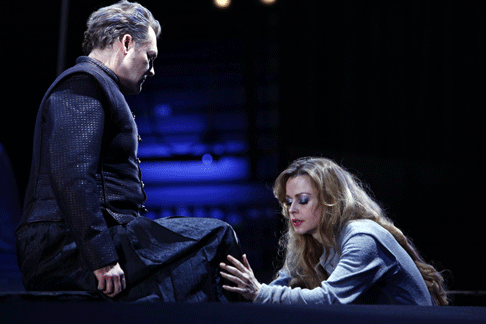Nietzsche and possibly most everyone else have been ever after bewildered by Wagner’s renunciation of love. After all love had always been the overwhelming motivation for the antics of Wagnerian mythology.
In 1883 Nietzsche began his winter sojourns to Nice and the mild winters of the French riviera where he envisioned his diatribe *Nietzsche contra Wagner*. But neither *Parsifal* nor any other Wagnerian masterpieces have been frequent visitors to this gentle climate of subtle sensual beauty. And not only because climatic subtlety and cruel philosophy seem at odds with one another, but also because when Nice re-built its opera house in 1882 the city fathers looked to old Italian theaters as models rather than to the latest theatrical theories and techniques from Bayreuth. Wagner’s mature operas are simply too huge to stuff into a small horse-shoe theater of delicate decoration.
The OpÈra de Nice is now considered one of the finest monuments of *belle Èpoque* architecture. With recent renovations and modifications it adequately serves much of the repertory. But for the really big stuff the OpÈra de Nice (the name of the opera company and its theater are the same) takes over the 2500 seat Salle Apollon in what is called the Acropolis, an architectural monstrosity designed in the late 1970‘s that holds five other performing spaces, an exhibition hall and a bowling alley or two as well.
The OpÈra de Nice is in transition, its new management transforming it into a somewhat adventurous opera company with a serious production standard. This production of *Parsifal* was its first adventure, and a striking success. Not that artistic chances were taken — it was the 2004 production from the Grand ThÈ‚tre de GenËve, the *metteurs en scËne* were the Swiss minimalist designer Roland Aeschlimann and the American minimalist choreographer Lucinda Childs. In Nice their original Geneva staging was realized by Dagmar Pischel who imbued it with vibrant new life.
This superb production was well served by a strong cast, led by Kurt Rydl as Gurnemanz whose dramatic presence never faltered and fortunately his voice gained focus as the afternoon progressed (January 17) making his lengthy narrations a powerful frame for Wagner’s Easter saga. Parsifal himself was American Gary Lehman who has effected a transition from baritone to a splendid heldentenor of total security with power to burn. He was willing to attempt the acting of the innocent fool (surely one of opera’s more thankless tasks) redeeming his seeming dramatic naivete with fine vocal art. Russian soprano Elena Zhidkova defined the many facets of Kundry with dramatic precision, and sang securely and beautifully, her second act seduction and supplication convincingly delivered, her third act submission uncomfortable to watch (Nietzsche would have wretched).

The antagonist was English baritone Peter Sidhom, the truly mad magician Klingsor who raged with Wagnerian *Èlan*, and was suitably stricken dumb. Finnish bass Jukka Rasilainen can and did possess a black tinted, i.e. colorless voice, ideal for the pitiful state of Amfortas, and well used to document his long suffering. He was well costumed in dreadlocks and black cloth, and then in white face for his death made poignant indeed with the dead Kundry draped across his lap. These two figures in this touching *piet‡* was the culminating moment of this sculptural production.
Aeschlimann and Childs made this *Parsifal* a ritual of death, the staging realized in poses and tableaus on a sloping stage platform broken by a long horizontal gash, its fore stage area embossed with the names of the knights of the Holy Grail, presumably their and perhaps our own tombs. The tabernacle was giant diminishing perfect circles where finally the grail appeared, a revolving faceted extra-terrestrial object that shone with all the cinematic panache of Stanley Kubrick’s *2001*.
This inspired minimalism allowed the vivid vocal and musical performances to prevail, and bring us to a state of purification — even Nietzsche found the music of *Parsifal* to be sublimely beautiful (and maybe finding sublimity is redemption enough these days). Conductor Philippe Auguin paced the prelude very slowly, at first excruciatingly slow, but with time this unworldly pace took us to another realm — rarified teutonic mythology — and it was here that some of Wagner’s greatest music poured forth from the Orchestre Philharmonique de Nice for nearly five hours. Perhaps the poetry of Bayreuth was missing (and we did applaud after the first act), but very real Wagnerian musico-sensual pleasures were notably apparent making this Parsifal’s redemption an unforgettable afternoon on the Cote d’Azur.
N.B. All the subordinate roles were taken by quite accomplished, i.e. world class, performers. This Parsifal was an auspicious new beginning for the OpÈra de Nice.
Michael Milenski
image=http://www.operatoday.com/Parsifal_Cote_1.gif
image_description=Parsifal, OpÈra de Nice
product=yes
product_title=Richard Wagner: Parsifal
product_by=Parsifal: Gary Lehman; Kundry: Elena Zhidkova; Amfortas: Jukka Rasilainen; Gurnemanz: Kurt Rydl; Titurel: Victor von Halem; Klingsor: Peter Sidhom; Two Knights: Yuri Kissin, Richard Rittelmann; Four Squires: Caroline Mutel, Marie Gautrot, William van der Heyden, Antoine Normand; Six Florwer Maidens: Barbara Ducret, StÈphanie Loris, Marie Gautrot, Catherine Hunold, Caroline Mutel, Lucie Roche. Conductor; Philippe Auguin. Mise en scËne and sets: Roland Aeschlimann. Choreography: Lucinda Childs. Stage Director: Dagmar Pischel. Costumes: Susanne Raschig. Lighting: Lukas Kaltenback. Orchestre Philharmonique de l’OpÈra de Nice. Choir of the OpÈra de Nice. Childrens Chorus of the OpÈra de Nice.
product_id=Photographs: Ville de Nice / P.Tallon